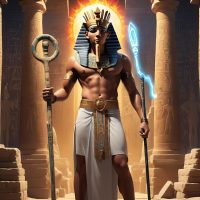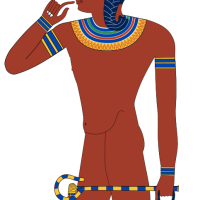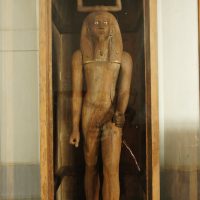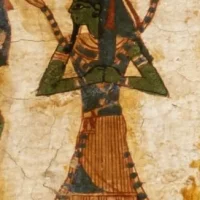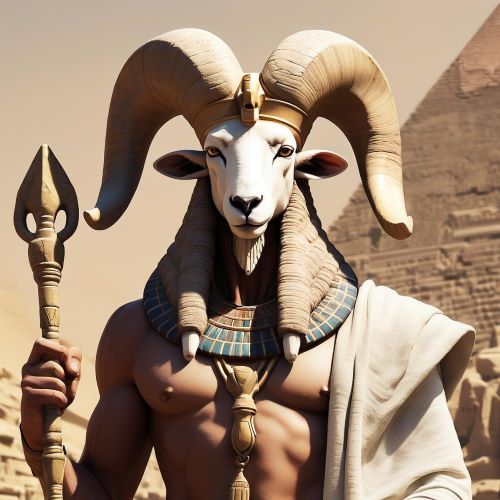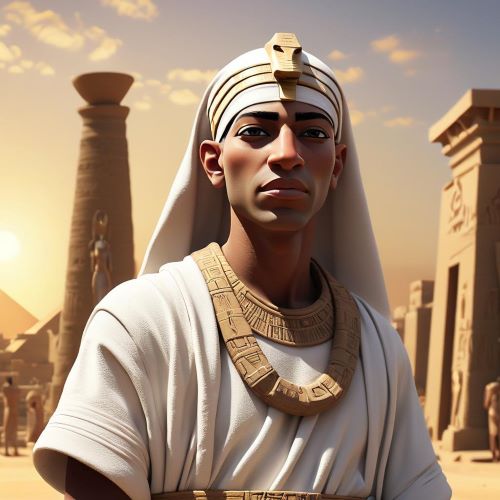Heka : God of Magic
Listen
At a glance
| Description | |
|---|---|
| Origin | Egyptian Mythology |
| Classification | Gods |
| Family Members | Khnum (Father) |
| Region | Egypt |
| Associated With | Magic, Healing |
Heka
Introduction
In ancient Egyptian mythology, Heka was far more than a god—he was the very embodiment of magic itself. The word heka (ḥkꜣ) literally translates to “magic” or “magical power,” representing both a divine energy and the practice of magic that sustained the cosmos. Ancient Egyptians believed that the universe was created and maintained through Heka’s power, which infused gods, humans, and all living things. Magic, in this worldview, was not an illusion or superstition but a sacred force that ensured balance, healing, and creation. Heka was both the origin and essence of this power, predating even the gods and enabling them to act. His presence was invoked in religious rites, healing rituals, and funerary practices, making him one of the most central figures in Egyptian theology from the Predynastic Period (around 6000 BCE) to the end of the Pharaonic era.
Physical Traits
Depictions of Heka emphasize his divine authority and eternal power. He is usually shown as a man holding a staff and a knife—symbols of command and protection. At times, he carries the ankh (representing life) and the crook and flail, both emblems of kingship, suggesting that Heka governed not only over magic but also over the life force itself. In several temple reliefs, he is seen strangling two serpents, an image that symbolizes his victory over chaos and his ability to control dangerous forces. This serpent imagery may have inspired the later Greek caduceus, the symbol of medicine and healing. Heka is sometimes portrayed as a child, emphasizing renewal and vitality, or wearing the Hemhem crown, associated with divine rebirth. His flexible iconography reflects his abstract, omnipresent nature—he was everywhere, in everything, and beyond physical limitation.
Family
The genealogy of Heka differs across Egypt’s various cult centers, underscoring his universal rather than localized identity. In Esna (ancient Latopolis), he is said to be the son of the creator god Khnum and the lioness goddess Menhit, forming part of the Esna Triad. In this tradition, Khnum breathes the Ka—the life essence—into human beings, while Heka provides the magical power that sustains it. Other traditions identify Neith, the primordial mother goddess, or Mehet-Weret, the celestial cow, as his mother. Some later theological schools, especially those centered around Heliopolis, regarded Heka not as a child of any god but as an elemental force that existed before all creation. In the Coffin Texts, Heka even claims, “To me belonged the universe before you gods came into being,” asserting his precedence over all divine and mortal life. This statement defines him as a primordial essence rather than a being with mortal-like lineage.
Other names
The name “Heka” became synonymous with the concept of magic itself. Every spell, incantation, or ritual act was considered an expression of Heka’s divine energy. Sometimes, his name was rendered as Hekau, referring to “words of power” or magical utterances, reflecting the Egyptian belief in the creative potency of speech. In some Coptic texts, the name appears as Hik, showing its linguistic continuity through later periods. Related deities also bore his influence: Weret Hekau, meaning “Great of Magic,” was a goddess associated with protective magic and royal crowns. Heka’s presence in such divine titles demonstrates that he was not merely a singular deity but a pervasive principle, woven through the entire fabric of Egyptian spirituality and linguistic thought.
Powers and Abilities
Heka was not only the god of magic—he was magic itself. His power permeated all creation, enabling both gods and mortals to perform acts beyond the natural order. In the Coffin Texts and Pyramid Texts, Heka is portrayed as the energy that allows the creator gods to bring the world into existence. Without him, even Ra, the sun god, could not rise, nor could Atum form the first mound of creation. Heka’s power was morally neutral; it could heal or destroy depending on the user’s intent. Egyptian physicians invoked him during medical procedures, believing that physical and spiritual ailments stemmed from disruptions in the cosmic balance of Heka. Temples such as the Per-Ankh (“House of Life”) preserved magical and medical texts that relied on his energy to restore harmony.
In the divine realm, Heka accompanied Ra on his solar barque, defending the god against the serpent of chaos, Apophis, during the nightly journey through the underworld. This myth reflects Heka’s role as a stabilizing force, maintaining the balance of Ma’at—the cosmic order. Heka was also crucial in funerary magic; he protected the souls of the deceased, guiding them through the afterlife’s perils and ensuring their rebirth. Through spells, amulets, and rituals, Egyptians invoked Heka’s power to safeguard the dead and facilitate their transformation into eternal beings. Every ritual—whether for healing, protection, love, or cursing enemies—was an act of Heka, demonstrating that magic was as essential to daily life as it was to divine creation.
Modern Day Influence
Although ancient Egyptian religion faded with the rise of Christianity and Islam, the concept of Heka never entirely disappeared. The symbol of the twin-serpent staff associated with Heka survived into Greek and Roman iconography, ultimately becoming the caduceus, now recognized globally as a symbol of medicine and healing. Scholars and spiritual practitioners continue to study Heka’s role to better understand how ancient Egyptians perceived the interplay of science, spirituality, and natural law. In modern Kemetic (Egyptian Reconstructionist) and Neopagan traditions, Heka is revered as the divine embodiment of willpower, speech, and transformation. Practitioners interpret him as the energy that connects word and reality—an idea mirrored in modern psychology’s understanding of affirmations and intention.
In popular culture, Heka’s name and concept have resurfaced in books, films, and video games as symbols of mystical wisdom and ancient power. Academic studies also highlight how the Egyptian view of magic, grounded in Heka, influenced later philosophies such as Hermeticism and Alchemy, which sought to merge divine understanding with practical transformation. Even healing systems like Seichim or Sekhem Reiki trace their conceptual roots to the ancient Egyptian view of Heka as the universal life force.
Related Images
Source
Britannica. (1998, July 19). Heka | Magic, Rituals & Spells. Encyclopaedia Britannica. Retrieved from https://www.britannica.com/topic/heka
Goelet, O. (1994). The Egyptian Book of the Dead: The Book of Going Forth by Day. Chronicle Books.
Mark, J. J. (2017, February 22). Heka. World History Encyclopedia. Retrieved from https://www.worldhistory.org/Heka/
Ritner, R. K. (1993). The Mechanics of Ancient Egyptian Magical Practice. University of Chicago Press.
Study.com. (1999). Heka, the Ancient Egyptian God: Origin & Deification. Retrieved from https://study.com/academy/lesson/heka-egyptian-god-magic-medicine-origin-mythology-facts.html
Fiveable. (2024, July 21). Concepts of Heka and Egyptian Magic. Retrieved from https://fiveable.me
Wikipedia. (2002, September 30). Heka (god). Retrieved from https://en.wikipedia.org/wiki/Heka_(god)[1]
Frankfurter, D. (2018). Religion in the Making: Lived Ancient Religion Approach. Religion, Taylor & Francis.
Pinch, G. (2002). Egyptian Myth: A Very Short Introduction. Oxford University Press.
Faulkner, R. O. (1973). The Ancient Egyptian Coffin Texts. Aris & Phillips Ltd.
Nunn, J. F. (1996). Ancient Egyptian Medicine. University of Oklahoma Press.
Hornung, E. (1999). The Secret Lore of Egypt: Its Impact on the West. Cornell University Press.
Ritner, R. K. (1993). The Mechanics of Ancient Egyptian Magical Practice. Oriental Institute of the University of Chicago.
Frequently Asked Questions
What is lorem Ipsum?
I am text block. Click edit button to change this text. Lorem ipsum dolor sit amet, consectetur adipiscing elit. Ut elit tellus, luctus nec ullamcorper mattis, pulvinar dapibus leo.
What is lorem Ipsum?
I am text block. Click edit button to change this text. Lorem ipsum dolor sit amet, consectetur adipiscing elit. Ut elit tellus, luctus nec ullamcorper mattis, pulvinar dapibus leo.
What is lorem Ipsum?
I am text block. Click edit button to change this text. Lorem ipsum dolor sit amet, consectetur adipiscing elit. Ut elit tellus, luctus nec ullamcorper mattis, pulvinar dapibus leo.
What is lorem Ipsum?
I am text block. Click edit button to change this text. Lorem ipsum dolor sit amet, consectetur adipiscing elit. Ut elit tellus, luctus nec ullamcorper mattis, pulvinar dapibus leo.
What is lorem Ipsum?
I am text block. Click edit button to change this text. Lorem ipsum dolor sit amet, consectetur adipiscing elit. Ut elit tellus, luctus nec ullamcorper mattis, pulvinar dapibus leo.


